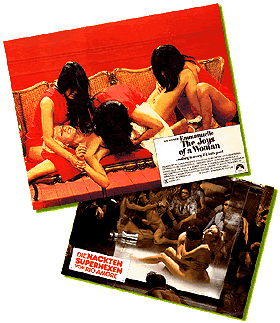
Hollywood is halo hunting. In the post-Columbine media environment, an already tame Hollywood is watering down movies so they offend absolutely no one and excising, whenever possible, any "gratuitous" violence.
The current non-hit Mystery Men boasts dysfunctional superheroes who, it's pointed out, use non-lethal weapons. Subtle. Meanwhile, Miramax took the silly measure of changing the title of Killing Mrs. Tingle to Teaching Mrs. Tingle -- even though it would have bombed either way -- and may now be pressuring director Kevin Smith to tone down the violence in his upcoming controversial film Dogma.
This crusade has since come to encompass both sex and violence in films, raising the question: Why did sex get thrown in there? Because, in the calculus of conservative pressure groups, "sex" is appended to whatever the target issue happens to be. But, if anything, Columbine was caused by a lack of sex, not too much of it. Once again, it seems, the horny people of America are paying for the crimes of the sexually repressed.
I fondly remember a raunchier time, some 25 years ago, when New York Times film critics reviewed porn films, when Americans paid to see A Clockwork Orange, Death Wish 2, and Last Tango in Paris. But as violent and sexually explicit as those films were, they were pale reflections of the most sex-and-violence- drenched precinct of film history -- European films of the 1970s (aka The Cinema without Shame).
For Craig Ledbetter, who runs a video outlet specializing in obscure European sex, horror, and crime films, nothing tops those Euro-flicks for their unrepentant (and uncensored) exploration of deviant forms of pleasure and terror. From the annals of his extensive European Trash Cinema video collection -- online at www.diabolik.demon.co.uk -- you can savor some the underground genres that could only have existed in the '70s.
Gems include the sadomasochistic Nazi sex films (like SS Hellcamp and She Devils of the SS), which often center around a dominant female camp commandant who uses prisoners for cruel medical experiments and/or kinky sex, and typically end with a prison riot that consumes everyone in the cast -- but not before they've all been gang raped by the off-duty Gestapo.
Then there are films like They Call Her One Eye (1974), in which a young woman is kidnapped, raped, and forced to be a heroin junkie. Her captor/pimp then pulls out her eye to ensure she remains loyal to him forever -- a dubious strategy at best. Gradually, she recuperates and seeks her revenge, ultimately burying the slimeball in the ground up to his neck and decapitating him by tying his head to a moving horse. To make matters worse, or possibly better, the entire film is in Swedish without subtitles -- which Ledbetter feels is not an impediment to viewing. "It's not like the main character is quoting great poetry here," he says
He also thinks "Americans have a real consistent history of taking whatever is good from a European production and just sucking the life out of it, then blanderizing it for Middle America." ETC carries uncut versions of films released in the U.S. in censored form, including the longer version of Luc Besson's The Professional, which contains additional footage of the budding sexual tension between French actor Jean Reno and underage vixen-assassin Natalie Portman.
And if you're looking for a raunchier European equivalent of a recent U.S. film, Ledbetter can probably produce it. If you, for some reason, liked Mel Gibson's Payback, try British crime flicks like 1971's Get Carter with Michael Caine or The Squeeze (1977). For the prototype of The Blair Witch's is-it-real-or-is-it-a-movie promotional hype, try the 1979 Italian horror film Cannibal Holocaust -- it's Blair Witch on acid. But whatever you do, don't make it a Blockbuster evening. The video chain doesn't even carry NC-17 films, let alone Eurotrash classics like Sexual Aberrations of a Housewife and I Bought a Vampire Motorcycle.
Peter Braunstein writes about film and pop culture for the Village Voice, and is currently co-editing an anthology on the 1960's counterculture.
